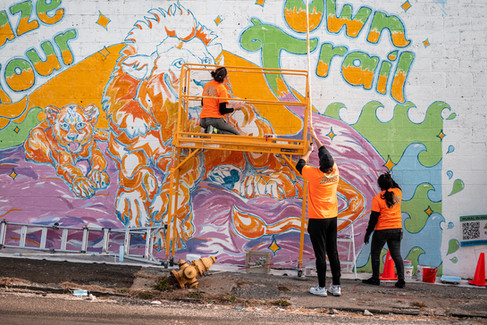Public art has been produced throughout the ages. On countless continents scattered across the Earth, for as far as records can account, people have been etching illustrations and messages onto public exteriors.
Through their work and throughout time, artists have painted pieces of themselves on communal canvases. Inspiring hope and leaving imprints on the world, artists declare through decoration and affirm to audiences, “I, too, was here.”
From cave carvings to making a mural that cultivates community, artist masterpieces past and present carry on a long-lived tradition of leaving their mark among shared spaces.
RiseUP Projects Featured Above: Top Row: Jaii Marc Renee, Michael Rice Middle Row: Corey Pane, Michael Rice Lower Row: Alissa Siegal, Corey Pane
Picture This: Primal Public Art of the Past
From around 35,000 – 11,00 B.C.E., 18 caves, also known as the “Cave Art of Altamira,” were imprinted with drawings In Northern Spain. The paintings depicted wild animals like buffalo, deer, and horses and ways of life for people during the Paleolithic Age — around 22,000 to 13,000 years ago.
In Southwestern France, the paleolithic “Hall of the Bulls” Cave Paintings in Lascaux are estimated to be from 16,000 B.C.E. to 14,000 B.C.E. Approximately 15,000 years old, the images were drawn with charcoal and natural elements and pictures included bears, bison, deer, elk, horses, lions, and a rhinoceros.
Ancient Inscriptions and Credible Accounts of Culture
Around 3,000 years ago, Mayans etched drawings and writings onto various surfaces. Mayan public art attested to collective belief systems and cultural practices, from monuments and sculptures in public squares to calendars and carvings.
Nearly 2,000 years ago in Pompeii, public art was regarded as a social interaction rather than a vandal nuisance and typically consisted of impulsive inscriptions and artistic markings from marginal groups. Ancient Roman citizens regularly marked public walls with well wishes, spells, political slogans, and prose about love.
Murals over 1,500 years old were ornamented on a tomb of a Northern Qi dynasty military commander and his wife in Shuozhou City, China. The walls of the tomb illustrate the couple attending a banquet, guards with swords, horses, and musicians, with a dark domed ceiling signifying the infinite sky.
Bonampak, an ancient Mayan city — now located in Chiapas, Mexico, contains the “Temple of Murals,” constructed in 790 C.E., over 1200 years ago. The temple of detailed drawings documents ancient Mayan musical instruments, political dynamics, rituals, and war practices.
From 1400 to 1500 C.E., religious wall paintings like Masaccio and Masolino’s “Brancacci Chapel”— frescos detailing the life of Saint Peter in Florence, Italy — were popularized. Like the “Brancacci Chapel,” emerging works featured ariel and linear perspective, detail, shadow, storytelling, and realism during the Early Renaissance Era.
In 1541 C.E., 482 years ago, Michelangelo completed "The Last Judgement" in the Sistine Chapel in Vatican City, Italy. He painted over 300 detailed figures while blending themes of faith, fate, Heaven, Hell, and the hereafter into the historic work of art.
The First Public Art Association in America
The Association for Public Art was established in 1872 and is the nation’s first private non-profit civic organization dedicated to creating a “museum without walls.” Formed in Philadelphia, Pennsylvania, the Association integrates accessible art and urban design with innovative programs and advocacy initiatives.
The non-profit organization recognizes that public artworks art can be big or small, with abstract or realistic shapes, and it can be assembled, built, cast, carved, or painted.
A collective community expression, the Association promotes that public art enhances our environment, heightens our awareness, transforms landscapes, questions our assumptions, and reflects how we collectively see the world.
Public Art: Portraying American People and Principles
In 1893, the Chicago World’s Fair introduced new ways for municipal architecture and art design to represent government aspirations or reflect the public it served. During the 1890s to 1900s, the growth and modernization of cities emerged, and more government-funded spaces like hospitals, libraries, and post offices were developing.
As a result, an interest in decorating its walls began, and the City Beautiful Movement was born. The City Beautiful Movement introduced several beautification initiatives to architecture and urban planning environments to encourage public engagement.
Made in Mexico: Influential Community Murals
In the 1920s, painters were hired by the Mexican authorities to illustrate the Mexican Revolution and the goals of its new administration through mural public art. The three painters most recognized from this era were “Los Tres Grandes” — Diego Rivera, Jose Clemente Orozco, and David Alfaro Siqueiros. Collectively, their murals told complex narratives and highlighted the hopes of the government.
For the Love of Public Art: Leveraging United States Legislation
Diego Rivera believed that painting on the walls of public buildings was the highest form of art because it was accessible to all. Although Rivera mostly painted in Mexico, he was commissioned to paint “Detroit Industry” at the Detroit Institute of Arts in 1932.
The seven-panel piece is said to have inspired President Franklin D. Roosevelt to create The Works Progress Administration (W.P.A.) Federal Art Project — the first broad-scale art endeavor in the middle of the Great Depression. The Works Progress Administration commissioned artists needing employment to design posters and paint murals in various government buildings throughout the United States.
The public art initiative lasted eight years, from 1935 to 1943. Five-thousand artists were hired during this time, and 200,000 public artworks were made — with 2,500 murals specifically produced for federal buildings, hospitals, and post offices.
A few Federal Art Projects include the following:
1933 —Victor Arnautoff — “City Life,”— The Coit Tower, San Francisco, CA
1936 — Thomas Hart Benton — "A Social History of Missouri" — Missouri State Capital, Jefferson City, MO
1937 — Gordon K. Grant — "Agriculture & Industries of Ventura" — Ventura Post Office, San Buenaventura, CA
1939 — Harry Sternberg — "The Family Industry and Agriculture" — Ambler Post Office, Ambler, PA
1942 — Julius Woeltz — "The Bauxite Mines" — Saline County Courthouse, Benton, AR
1942 — Judson Smith — "Lake George" — Lake George Post Office, Lake George, NY
The Tag of American Troops
From 1939 to 1945, during WWII, the tag “Kilroy was here” contained a simple drawing of a baldheaded man with a prominent nose peeking over a wall. This public artwork was commonly associated with G.I.s and seen as a universal sign that American soldiers had come through a location, leaving their mark.
The Emergence of Public Art Programs
Established by Congress in 1965, the National Endowment for the Arts, a newly formed independent federal agency, helped promote public art into popularity and became the largest funder of the arts nationwide.
In America during the sixties and seventies, people moved into the suburbs, and many city buildings were dilapidated or anticipated to be torn down. Consequently, metropolises and affiliate art developers sought new ways to make downtown centers appealing and vibrant through art and architecture.
Public art of this innovative period includes:
1970 — Tania — Untitled Mural — New York, NY
1971 — Barron Krody — "Allegro" — Cincinnati, OH
1973 — Roland Hobart — "Urban Wall Mural" — Indianapolis, IN
1973 — Milton Glasner — "Color Fuses" — Indianapolis, IN
Profound Mexican American Murals Shift Public Art Messaging
Throughout the Southwest United States, the Chicano Art Movement frequently represented Mexican American cultural, economic, and political struggles.
Starting in the sixties, Chicano mural messages shifted from government-authorized artwork to activism, community, and giving a voice to the people. Public art murals were a tool for social causes. Advocates and allies illustrated themes of race riots, war protests, and other political issues of its time.
Permission & Public Art: From Graffiti to Gallery
Aerosol art exploded in Philadelphia and New York in the sixties and seventies, and graffiti artists advanced from images drawn on boxcars to full murals on the side of subway trains.
Amongst the debate of beautification or blight, unauthorized street artists assumed alternative identities to avoid legal prosecution, while other artists created “tag” names for comradery, street credit, and territorial claims.
In the eighties, the love for graffiti subculture found its audience formulating around various art galleries and even sustaining intrigue decades later.
Not long after the shift to socially conscious public art motifs, the familiar sentiment of painting without permission re-surfaced, and artists were getting their messages across by any means necessary. Public artists worked in cityscapes instead of studios. They created work that reflected collective strengths, and the art form spread to regions across the U.S. and beyond.
Select social murals that set the scene include:
1978 — Mario Terero — "We are Not a Minority" — Los Angeles, CA
Image from UC San Diego Library, 1979
1983 — Juana Alicia — "The Women Lettuce Workers/ Las Lechugueras" — San Francisco, CA
1986 — Keith Haring — "Crack is Whack" — New York, NY
1994 — John Zender Estrada — "Rescate" — Los Angeles, CA
2000 — Precita Eyes Muralists — "Soul Journey" — San Francisco, CA
2015 — Joel Artista with Israeli and Palestinian Youth — US Consulate, Jerusalem.
The Present-Day Preservation of Public Art
Today, U.S. organizations like RiseUP for Arts, Connecticut’s only statewide public art non-profit, keep the time-honored public art tradition alive.
Started in 2012 as an after-school and weekend mentoring program, the RiseUP organization initially connected career coaches to local youth and required attendees to participate in acts of community service.
In 2015, a RiseUP cohort decided to paint a large mural in Hartford for their required service project, and the RiseUP for Arts program took flight.
To date, RiseUP for Arts has:
Commissioned over 50 independent artists
Collaborated with over 100 local and global organizations
Produced over 100 public art projects, and
Organized over 1,000 community volunteers of service
Hear from their artists:
Since its inception, RiseUP has been proudly progressing communities through public art, mural projects, and creative placemaking experiences across Connecticut.
Are you an independent artist interested in working with RiseUP for Arts?
Are you a public art enthusiast seeking to support talented local artists?
Do you have a creative project that you want to see come to life?
Visit RiseUP for Arts to learn how you can
help carry on the age-old tradition of public art.

















